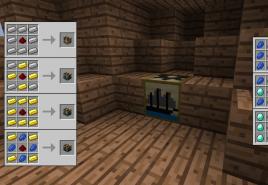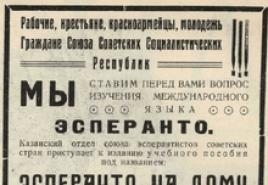Download sound charts teaching literacy. How to teach a younger student to make word patterns? Preschooler's workbook
How to make a sound scheme of a word?
Dear parents, at the stage of learning to read and write, children learn to make a sound scheme or, in other words, a model of a word. Help your child figure out how to make a sound model of a word.
I will give examples of sound schemes for the program "School of Russia". There, the designations of different sounds differ in color.
There are six vowels in Russian - [a], [o], [y], [s], [e], [and]
Consonants form pairs by hardness-softness, by deafness-voicedness.
There are unpaired consonants.
The soft sign and the hard sign do not represent sounds.
The letters I, Yo, Yu, E denote two sounds if they are at the beginning of a word or after a vowel sound, they denote one sound if they are after a consonant. 
In the table we see a letter and under it the sound or sounds that are denoted by this letter.
For example, the letter B denotes two sounds [b], [b "]. The letter Zh has one sound [g].
Let's analyze the compilation of a sound model of the word LETTER.
We divide the word into syllables: PI-SMO (you can find out how many syllables (parts) in a word by vowel sounds.How many vowels in a word, so many syllables).
The first syllable is pi. This is a merger. The vowel sound [and] denotes the softness of the consonant. The first sound [p "] is a soft consonant, the second sound [i] is a vowel.
The second syllable is CMO. The first sound [s "] is a soft consonant. Then comes the merger - MO. The vowel sound [o] indicates the hardness of the consonant. The sound [m] is a hard consonant. The sound [o] is a vowel. We put the stress.
As a result, the following scheme is obtained:

Then we do a transcription (as we hear the word).
Write down the word: letter.
The vowels that are in the top row of the tablet - a, o, u, s, e denote the hardness of the consonant sound.
The vowels i, e, e, yu are after the soft consonant, the sound [and] also denotes the softness of the consonant.
But it must be remembered that there are consonants that are always solid. They are indicated in the table only in blue: [g], [w], [c]. There are consonants that are always soft, they are indicated only in green: [h "], [u"], [th"].
Be careful when parsing words with iotized vowels.
Here is an example of parsing the word APPLE.

At the beginning of a word, iotated vowels represent two sounds.
I hope that the article helped you understand a little about the construction of the sound scheme of the word.
Dear parents, be sure to help the child if he fails. Praise the child for the smallest successes, even if it doesn’t work out, praise him for repeating after you correctly and completing the task.
As soon as parents begin to think about how to teach their child reading skills, in addition to letters and syllables, the concept of “sound analysis of the word” appears. However, not everyone understands why it is necessary to teach a child who cannot read to do it, because this can only cause confusion. But, as it turns out, the ability to write correctly in the future depends on the ability to correctly understand words into sounds.
Sound analysis of the word: what is it
First of all, it is necessary to give a definition. So, the sound analysis of a word is the definition in order of their placement of sounds in a particular word and the characteristics of their features.
Why do children need to learn to perform sound analysis of a word? To develop phonemic hearing, that is, the ability to clearly distinguish sounding sounds and not confuse words, for example: Tim - Dima. After all, if a child is not taught to clearly distinguish words by ear, he will not be able to write them down correctly. And this skill can be useful not only when studying the grammar of the native language, but also when studying the languages of other countries.
The order of parsing a word by sounds
When performing a sound analysis of any word, it is necessary first of all to put stress, then divide it into syllables. Then find out how many letters are in the word and how many sounds. The next step is to gradually analyze each sound. After that, it is calculated how many vowels and how many consonants are in the analyzed word. At first, it is better for children to give simple one-syllable or two-syllable words for analysis, for example, their names: Vanya, Katya, Anya and others.
When the child has gradually figured out how to correctly analyze simple examples, it is worth complicating the parsed examples of words.
Sound analysis of the word: scheme
When working with the youngest children, special colored cards are used to better assimilate information.

With their help, children learn to create a sound analysis scheme.
The scarlet color card is used to represent vowel sounds. Blue - hard consonants, green - soft. To designate syllables, two-color cards in the same color scheme are used. With their help, you can teach your child to characterize sounds and whole syllables. You also need a card to indicate stress and a card showing the division of the word into syllables. All these designations, which help teach a child to make a sound analysis of a word (the scheme plays an important role in this), are approved by the official school curriculum in Russia.
Vowels are their brief description. diphthongs
Before starting to analyze a word, it is important to know what features all phonetic sounds (vowels / consonants) have. When teaching children in the early stages, it is necessary to give information only about the simplest properties, the child will learn everything else in the upper grades.
Vowels (there are six of them: [o], [a], [e], [s], [y], [and]) are stressed / unstressed.
Also in Russian there are letters that in a certain position can give a couple of sounds - e [yo], yu [yu], i [ya], e [ye].

If they follow consonants, they sound like one sound and give softness to the previous sound. In other positions (the beginning of the word, after the vowels and "b" and "b") they sound like 2 sounds.
Brief description of consonants
There are thirty-six consonants in our language, but only twenty-one signs represent them graphically. Consonants are hard and soft, as well as voiced and deaf. Also, they may / may not form pairs.
The table below lists voiced and unvoiced sounds that can pair, and those that do not.

It is worth remembering: the consonants [y`], [h`], [u`] in any position are soft, and the consonants [g], [c], [w] are always hard. Sounds [c], [x], [h `], [u`] - absolutely always are deaf, [m], [n], [l], [r], [d `] - (sonorous) or voiced .
Soft and hard signs do not make sounds. The soft sign makes the previous consonant soft, and the hard sign plays the role of a sound separator (for example, an apostrophe plays a similar role in Ukrainian).
Examples of sound analysis of words: "language" and "group"
Having dealt with the theory, it is worth trying to practice.

For example, you can conduct a sound analysis of the word "language". This word is quite simple, and even a beginner can understand it.
1) In this example, two syllables "I-language". 2 syllable is stressed
2) The first syllable is formed using the diphthong "I", which is at the beginning of the word, and therefore consists of 2 sounds [y'a]. The sound [y`] is a consonant (accord.), soft (soft) (green card), the second sound [a] is a vowel, unstressed (scarlet card). To designate this syllable in the scheme, you can also take a two-color green-red card.
4) Syllable 2 "language". It consists of three sounds [h], [s], [k]. Consonant [h] - solid, voiced (blue card). Sound [s] - vowel, stressed (red card). Sound [k] - acc., solid, deaf. (card in blue).
5) Stress is placed and checked by changing the analyzed word.
6) So in the word "language" there are two syllables, four letters and five sounds.
It is worth considering one point: in this example, the word "language" was understood as for first-grade students who do not yet know that some vowels in an unstressed position can give other sounds. In high school, when students deepen their knowledge of phonetics, they will learn that in the word "language" unstressed [a] is pronounced like [and] - [yizyk].
Sound analysis of the word "group".
1) In the analyzed example, there are 2 syllables: “group-ppa”. 1 syllable is stressed.
2) The syllable "gru" consists of three sounds [gru]. The first [g] - acc., solid., ringing. (card in blue). Sound [r] - acc., solid., ringing. (card in blue). Sound [y] - vowel, percussion. (scarlet card).
3) A card is placed in the scheme, indicating the division of syllables.
4) There are three letters in the second syllable "ppa", but they produce only 2 sounds [n: a]. Sound [p:] - acc., solid, deaf. (card in blue). It is also paired and pronounced long (blue card). Sound [a] - vowel, unstressed (scarlet card).
5) Emphasis is placed in the scheme.
6) So, the word "group" consists of 2 syllables, six letters and five sounds.
The ability to do the simplest sound analysis of a word is not something complicated, in fact it is a rather simple process, but a lot depends on it, especially if the child has problems with diction. If you figure out how to do it correctly, it will help you pronounce words in your native language without errors and will contribute to the development of the ability to write them correctly.
Sound-letter analysis is needed in order to train the child to first read words as it is written, and then ask him to read orthoepic ones, that is, as usual in oral speech. The sooner you start these activities with your child, the better your preschoolers will have reading and spelling skills.
In order to conduct a positional analysis of words and convey this learning and skill to preschoolers, one needs to conduct sound analysis. Determine where the sound is heard - at the beginning of the word, at the end or in the middle. The beginning of a word is considered the first sound, the end - the last. The middle of a word is not the first and not the last sound.
In order for children to understand what such an analysis of a word consists in, you need to pronounce the word, highlighting, albeit slightly exaggerated, the sound we need. To make learning for preschoolers more understandable, we give examples. In the word stork, we need to understand where the desired sound “a” is located.
Sound analysis of words
Start pronouncing the word a-a-a-stork and you will understand that the sound is at the beginning of the word. In the word sha-a-a-arik, "a" is in the middle of the word. Such a scheme will be simple and logical, and it will help to conduct a positional analysis of words and consolidate this skill in preschoolers.
Pictures and schemes

It is very convenient to conduct sound analysis and teach it with the help of diagrams and pictures for them. Before you start performing sound analysis, you need to understand that sounds are vowels, hard consonants and soft consonants.
In order for each child in a group of other children studying Russian to normally learn all the subtleties of analysis, pictures and diagrams will need to be used. Usually this is a picture, under which there are empty cells, in which you need to schematically enter the letter-syllabic analysis of the word. Often the kindergarten preparatory group uses colored chips in such tasks that mean certain sounds.
It is also acceptable to use the same colored chips in the senior group. Chips can be made in the form of circles, squares or magnets, the correct use of which indicates that the child can analyze words by sound analysis. This skill is extremely important when teaching a child to read and write. Thanks to this, children develop speech, they better learn and understand the Russian language.
Using a picture with word parsing schemes can be used as a game, because learning to read and write should not be boring. The game can be competitive in nature, or it can be used so that children simply hone their speech and learn Russian better. Sound synthesis is also very important, as it is the process of combining sounds into words. Sound synthesis is at the heart of the reading process.
The order of parsing a word by sounds
To analyze words according to the sound criterion, you will need to use approximately the same scheme that all teachers use when teaching literacy. In order for the parsing of the word to be correct and successful, you need:
- The word chosen for sound analysis must be pronounced aloud and using the correct stress. Without listening to the sound of a word, you will not be able to characterize its phonetic side. Such pronunciation should take place as a game, you do not need to pronounce each letter separately, as your speech will only be distorted. Usually children perceive such exercises as game learning. The ability to conduct sound synthesis is instilled in children, the Russian language is better absorbed with pronunciation and literacy is taught.
- You need to write down the phonetic transcription. Making out the graphic sounding of words, it will be necessary to take into account some features of the sounding of sounds. For example, the letters I, Yu, E, Yo do not have a separate sound. They are denoted by two sounds, but in weak positions the iotized overtone disappears.
- Each of the words will need to be divided into the available number of syllables. Keep in mind that the number of syllables in a word will be equal to the number of vowels. Syllabic analysis must be done using phonetic transcription.
- After highlighting syllables, you will need to put stress. So it will be possible to determine the main ones in a weak and strong position. If the main one is in a strong position, then it contributes to the fact that the sound will be clearer and the speech will be beautiful.
- All sounds will need to be characterized. The vowel can be stressed and unstressed, the consonant can be soft, voiced, hard or deaf.
- You will need to specify the number of sounds and the number of letters. Their number is often not the same. For example, b and b are not made out with sounds, and letters such as I, Yu, E, E are usually indicated by two sounds.
Phonetic parsing

Children should know that in order for speech to be beautiful, it is necessary not only to learn spelling and literacy, but also to try to perform phonetic syllabic analysis and sound synthesis. The language is quite complex and children best perceive the analysis of syllables, synthesis and all kinds of rules in literacy, if they are presented as a learning game.
The sounds A, O, U, S, E indicate a solid consonant sound. I, E, Yu, I, E indicate a soft consonant sound. When studying language, speech and phonetic synthesis, children should understand that such a learning process is a kind of game where the language is first decomposed into components and its synthesis takes place. Sounds L, M, N, R, Y - unpaired calls are consonant sounds. X, C, Ch, U are soft consonants. B, C, D, D, F, Z - paired voiced consonants, P, F, K, T, W, C - paired deaf consonants, Zh, Sh, C - hard, and Ch, W, Y - soft.
With the beginning of autumn, adults often have to sit down for lessons with their children. It is difficult for parents of first-graders, since the elementary school program is quickly forgotten, and educational standards often change. Even before the beginning of reading and writing, when yesterday's preschoolers in grade 1 go through the alphabet, they are given the task of compiling a sound scheme for both a word and a whole sentence. In such cases, parents come to the aid of the Internet with examples and samples.
Sound-letter analysis of words
The study of letters and sounds, their analysis is carried out by a section of the Russian language called phonetics. Transcription is used to decompose a word into sounds. Such analysis is called phonetic. Parents will need to remember what vowels and consonants are, what sounds correspond to them, what iotized vowels are, and how the letters of the first and second rows differ.
Table of vowels and consonants of the Russian language
You can find the letter row in books for elementary grades or on the Internet. As a rule, the letters are arranged in two lines. Vowels are divided into denoting softness and hardness of consonants, the latter - into deaf and voiced, paired and unpaired.
Vowels that determine hardness: a, e, o, u, s. They correspond to the sounds: [a], [e], [o], [y], [s].
Softness vowels: i, e, e, yu, i. They are also called iotated, because these letters consist of two sounds if they are at the beginning, after a vowel, or after soft and hard signs. These letters soften the consonants that precede them.
Consonants are deaf and voiced, they form six pairs:
- B (voiced) - P (deaf);
- V - F;
- Z - S;
- D - T;
- G - K;
- J - Sh.
The remaining consonants are not paired:
- voiced: N, R, L, M, Y;
- deaf: Ts, Shch, X, Ch.
In addition, there are consonants that are always soft or always hard, regardless of the vowel that follows them:
- H, W, Y - always soft.
- W, W, C - always solid.

The letters b and b do not have their own sounds. A soft sign softens the consonant in front, a hard one does not.
The scheme of letters and sounds of the Russian language in the table for the first class is shown in the picture:
In the educational program "School of Russia" it is customary to designate sounds with colors:
- Vowel - red;
- Consonant solid - blue;
- Consonant soft - green.
The merging of a consonant and a vowel is indicated by a rectangle divided in half. One part is painted over in blue or green, the second - in red. Sometimes in this model voiceless and voiced consonants, stress and division into syllables are additionally indicated.

Examples
For a graphic representation of the sound composition of a word, you can pick up colored cards. To facilitate the drawing up of the diagram at the beginning, it is advisable to use the captions on the pictures. In the future, you can independently draw a schematic composition of the word in a notebook by cells using colored pens or pencils.
To show the algorithm for drawing up a diagram, it is better to start with the sound recording of monosyllabic words using a tablet.

For example, three-letter words: oak, cat, poppy, onion, beetle, cancer. First you need to write a transcript.
For the word "oak" it looks like this: [dup]. Next, describe the scheme, where the first two sounds represent the fusion of a solid consonant and a vowel, and the third is a solid consonant. Now we need to graphically depict the result:
- First draw a rectangle.
- Divide it in half diagonally.
- Color the first part in blue, the second in red.
- Then draw a square and color it blue.

The remaining words also fit the resulting scheme.
Variants where one or both of the consonants are soft:

Words of 4 sounds, consisting of a single syllable:

Words with 2 syllables:

A few more examples of 2 syllables or more:
- Cone, pine:

- Squirrel, cup: there is a soft consonant

- Skirt: Y at the beginning

- Banana, giraffe:

- Lemon, rooster:

- Hedgehog: always hard F and iotated Yo at the beginning

- Coat:

- Bee, plum:

- Crow, dog:

- Rocket:

How to draft an offer
A common variant of tasks for first graders is to draw up a sentence scheme. This is a simple task. Here it is not required to remember the designations for subjects and predicates. All words in a sentence are indicated by horizontal lines. If the word is capitalized, then a vertical bar is drawn at the beginning of the line. End with a period, exclamation point, or question mark.

Examples
Examples of how to decompose several sentences:

Syllabary Patterns
When teaching reading, first graders are taught how to decompose a word into syllables. To do this, it is enough to remember that a vowel forms a syllable. For example, the word "leaf" has one syllable, and the word "leaves" has two.

Thus, the syllable may consist of:
- From one vowel: Stork, Anchor.
- Start with a consonant and contain a vowel: Tree.
- Consonants without a vowel, Y, b and b depart from the previous syllable: Boy, Heron, Seagull, Kettle.
- Consonants go to the syllable from the vowel: Watermelon, Screen, Astra.
- At the beginning of a word, all consonants join the first vowel: Swift, Dragonfly.
In the pictures, examples of words decomposed into syllables:

Now you can try to decompose the word "Dolphin" into syllables yourself. And solve the next problem.

28.07.2011
The visual aid "Steps of literacy" has been revised and supplemented taking into account its use with other aids of the educational and methodological set "Teaching preschoolers to read and write".
Contains: alphabet in pictures; pictures-diagrams with the image of an object and a number of cells under it to highlight the sounds of a word; strips-diagrams of the sound composition of words; subject pictures for verbal didactic games and game exercises; chips-cards for designating the selected sounds of the analyzed word; manual "Windows" for teaching children syllabic reading; split vowels; split alphabet (uppercase and lowercase letters); cards with rules for writing vowels after soft and hard consonants; an approximate scheme of work with the manual "Steps of literacy".
With the help of this manual, children learn to sequentially distinguish sounds in a word intonation, name and characterize vowel sounds, consonant sounds (hard and soft, voiced and deaf), designate them with colored chips in the form of a scheme of the sound composition of the word; get acquainted with the rules for writing vowels after hard and soft consonants; lay out words and sentences from the letters of the split alphabet.
These knowledge, skills and abilities will contribute to the further successful teaching of children to meaningful reading and literate writing at school.
The kit consists of three parts:
I. "Steps of literacy." Visual and demonstration aid with cutting material (58 tables, A3 format).
II. "Step by step on the steps of literacy". Workbook for a preschooler with cutting material (32 pages, format 60x90/8).
III. Methodical manual "Teaching preschoolers to read and write." A program with methodological recommendations for organizing and conducting game classes for the EMC "Teaching preschoolers to read and write" (192 pages, format 70x100 / 16).
I. Literacy demonstration material
"Steps of literacy" (58 tables of A3 format):
1. ABC in pictures.

2. Pictures-schemes of the sound composition of words(19 tables).
Each table contains an image of an object, the name of which the child must analyze, and a scheme of sounds - a series of cells (their number corresponds to the number of sounds in the word-name). In the process of sound analysis of the word, colored chips are laid out on the diagram corresponding to certain sounds. Chips are inserted into the pocket, which is formed by folding the bottom edge of the table under the diagram and fixing it along the side.



3. Stripes-schemes of the sound composition of words.
The manual contains 8 strips - 2 strips-schemes for the analysis of three-, four-, five- and six-sound words. They are used in the sound analysis of words both by handout or demonstration pictures, and without pictures when pronouncing a particular word. Colored chips are laid out on strips-schemes and inserted into pockets (similar to working with pictures-schemes).
4. Subject pictures.
For verbal didactic games and game exercises, the tables contain subject pictures: demonstration (60 cards) and handouts (84 cards). A list of pictures is given for each game lesson, including didactic games and game exercises. It is listed in the manual.

5. Chips-cards.
In the middle group, when designating the first sound in a word, 2 chips are used: a large blue circle for a hard consonant sound and a small green circle for a soft consonant sound.

In the senior and preparatory groups, to designate the selected sounds of the analyzed word, card chips- rectangles of different colors: 6 tokens of yellow, red, blue, green, black and white and 2 tokens of blue with a bell. At the beginning of training, yellow chips are used to highlight the sounds of a word, then they change: to red chips - when characterizing vowel sounds, blue or green - when characterizing consonant sounds (hard and soft, respectively). To indicate a voiced solid consonant sound, a blue chip with a bell is used. A black chip is used to indicate a stressed vowel sound, it is placed behind the red chip 1-2 cm higher.
6. Benefit "Windows».

The "Windows" manual is used to teach children syllabic reading. 2 tapes (strips) of letters - consonants are attached to the "windows" m, n, b, n, d, k, h, s, r, l and vowels a, i, o, e, y, u, s, i, e, e. During the lesson, the tape of consonants does not move until all syllables for a specific letter with all vowels are read.
7. Splitvowels.
Split vowels (preparatory group) are used at the stage of sound analysis of words when moving from sound to letter.

8. Split alphabet.
33 uppercase letters (2 sets) and 33 lowercase letters (4 sets) are used at the stage when children have learned the ability to distinguish sounds in a word and conduct its sound analysis, i.e. in the transition from sound to letter, by which the sound (or sounds) are denoted. When introducing children to the letters of the alphabet, colored (or white) rectangular chips that previously distinguished sounds in a word are replaced with letters corresponding to these sounds.
9.
Cards zhi-shi, cha-cha, chu-shu.

With the help of these cards, children learn the rules for writing vowels after soft or hard consonants.
10. Approximate scheme of work with the manual "Steps of literacy".



II. "FIRST STEPS ON THE STEPS OF LETTERS"
Preschooler's workbook
The workbook is used for classes with children in the middle, senior and preparatory groups of the kindergarten: the child repeats a specific task in it, which the teacher shows on the demonstration material of the tables “Letters of literacy”, or performs the task as directed by the teacher. The notebook will help a preschooler to practically master the ability to conduct a sound analysis of words, highlight vowels, hard and soft consonants, a stressed syllable and a stressed vowel, divide words into syllables, name words according to a given sound model, read syllables, words, simple sentences.
III. Manual "TEACHING PRESCHOOL CHILDREN TO LITERATURE".
The manual outlines the program of preparation for teaching literacy in kindergarten, provides methodological recommendations, describes the demonstration material of the tables "Steps of literacy", features of working with it and other books of teaching materials. Approximate plans and abstracts of classes in the middle, senior and preparatory groups (100 lessons in total) are given. Particular attention is paid to playing techniques and didactic games, which are the specifics of teaching preschool children.
Set price: 1200 rubles.






